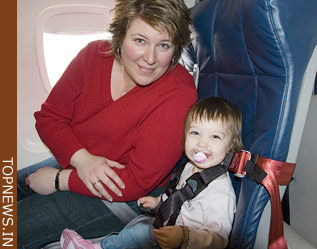Few "plane truths" when it comes to airline child safety seats
 Berlin - Stress is almost guaranteed when flying with a baby. But many parents find the hunt for a child safety seat, acceptable to international airlines and in compliance with various government guidelines, even more stressful.
Berlin - Stress is almost guaranteed when flying with a baby. But many parents find the hunt for a child safety seat, acceptable to international airlines and in compliance with various government guidelines, even more stressful.
Making the wrong choice can mean reserving a seat, buying or renting a safety seat and then learning just before takeoff that the seat does not pass muster. But not making the effort could mean foregoing basic safety precautions, some experts say.
Unfortunately, due to a complexity of differing national laws on child safety in airplanes, to say nothing of varying technical requirements among airlines and even airplanes in an airline's fleet, there are few rules of thumb to guide globetrotting parents.
So the quest to find a suitable safety seat for the flight home to show the baby off to doting grandparents becomes a headache.
Through the haze, two things are clear. Many safety groups say it is safest to travel with a car seat. And that, thanks to the stew of sometimes contradictory guidelines, it can be a challenge to figure out which seat will be accepted by your airline.
"There is no 'global' central place for information," says Alison Duquette, a spokeswoman for the US Federal Aviation Authority (FAA). "The best thing I can recommend is that parents contact the airline they plan to fly with and ask them for their specific rules and policies."
She notes that some airlines provide their own safety seats and refuse to let passengers bring their own. But some airlines, who claim to provide their own child seats, offer conflicting advice about whether their seats are actually safety seats. To make matters worse, those seats are often only offered on a first-come, first-serve basis.
The different takes on child safety in a plane can be dizzying. The European Union allows parents to secure their children during a flight with a loop belt - a kind of seat belt that secures the child to the parent. The Association of European Airlines terms them "perfectly safe." However, the FAA does not recognize loop belts.
Similarly, many airplanes offer bassinets - baby-size beds that can be strapped in beside a parent for the baby to sleep in. Again, the FAA says they are not considered safety devices, noting that there are no restraints and that the use of bassinets is banned during takeoff and landing.
That leaves holding a child on your lap, an unappealing option for any international flight of any length, or purchasing a space for your child and then finding an appropriate child safety device.
Parents who decide on that option again face a myriad of tough choices, says Martin Sperber, head of team aviation with TUEV Rhineland, a German consumer safety organization.
"The whole topic is not very simple," he said. "It is very complex."
So far, Sperber says, the best bet for a truly safe child seat on an airplane is finding one with a label bearing the designation FMVSS 283, for Federal Motor Vehicle Safety Standards, a designation granted by the US government.
Unfortunately, that test only looks at whether the seat meets safety standards, he notes. It does not guarantee an approved seat compatible with airline seats. Parents with a certified seat still need to check with the airline to make sure it will work with the seats on their airplanes.
And, even then, risks abound. Some airplanes use different seat styles, sometimes even within a single passenger section. Sperber says he has heard anecdotes of one couple failing to secure their child's seat in an airplane while a couple of rows ahead of them, another couple is installing theirs easily.
"Anything's possible," he said.
The only solution to the problem is standardization, he says. But airlines are not keen on setting more restrictions for themselves and governments face little pressure to draft standards, since most people who would normally lobby for change are unaware of the problem.
Those who are, often lose interest in the cause once their children have grown up and can use standard airline seats. (dpa)